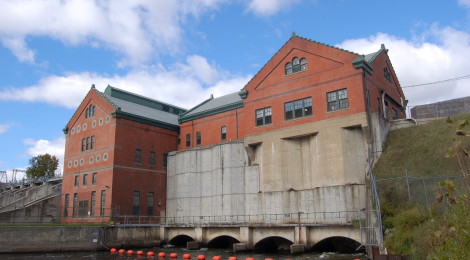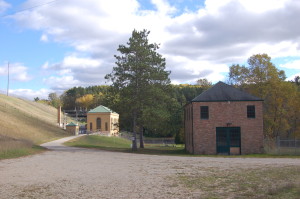
Croton and Hardy Dams in Newaygo County – Historic Landmarks on the Muskegon River
Michigan’s wild and roaring rivers are great places for boating, fishing, tubing, kayaking, swimming and many more outdoor activities. They are also home to a handful of spectacular dams that for decades have harnessed the rushing waters for hydroelectric power. Visitors to Newaygo County can stop by not one, but two of these historic structures by visiting the Croton Dam and Hardy Dam. Both of these well-constructed dams have stood the test of time well, and they are located just six miles apart on the Muskegon River.
The Croton Dam can be found in Croton Township, with a parking area located at the intersection of Croton-Hardy Dr. and Elm Ave. (a few miles north of M-82). This dam is 40 feet tall and was constructed in 1907. Consumers Energy currently owns and operates the dam, with access to the waters below the dam provided via a short walking path from the parking lot mentioned earlier. A Michigan historical marker at the parking area details the history of the dam:
The Grand Rapids – Muskegon Power Company (a predecessor to today’s Consumers Energy Company) built the Croton Hydroelectric Plant in 1906 – 1907. The plant and its 110,000-volt transmission line (the highest voltage in use at that time) attracted international attention. Curious spectators rode excursion trains to the site, were they received a tour of the dam and powerhouse, as well as a grand dinner. When the plant went into full service in September 1907 it represented the latest advances in electric power generation and transmission. Engineers from Russia, England, France, Italy, Japan, and India came to tour the plant when it opened. The facility is listed in the National Register of Historic Places.
From here, follow Croton-Hardy Rd. north for six miles, following the river until reaching 36th St. and a sign indicating the turn for Hardy Dam. Turn left here on 36th St., and you will soon reach a scenic park on the north side of the road before crossing the river. This is Operator’s Village Park, and it includes picnic and swimming areas, historic plaques and mementos, restrooms and walking trails. A Michigan historical marker can be found in this park and it details the history of this engineering landmark:
Constructed from 1929 to 1931, on a site once known as the Oxbow, the Hardy Hydroelectric Plant was built by Consumers Power Company. The plant was named for George Hardy, a partner in the firm that financed Consumers’ projects from 1911 through 1928. The complex includes a Spanish Colonial Revival-style powerhouse and intake tower, an oil house, and a dormitory. It originally included four operator’s houses on the eastern bank of the pond, which were Sears-Roebuck kit homes. Due to advancements in fossil fuel steam generating plants, this was the last conventional hydroelectric plant built by Consumers. The Hardy plant in listed in the National Register of Historic Places.
From the park you can head west and drive over the top of this dam, which was the largest earthen dam east of the Mississippi when it was constructed in the late 1920s. There is a parking area on the other side of the dam for the Hardy Dam Nature Trail and by parking there and walking back while following signs you can get down below the dam and explore several miles of nature trails.
The path heads along the top of the dam past a spillway, then turns and starts to head downhill. From the bottom of the hill there are chances to walk over to the river and see the dam while the trail continues for about a quarter mile before entering the woods.
These two dams plus another on the Muskegon (Rogers) can provide 45,500 kilowatts of energy – enough to serve 23,000 customers. If you’re headed to Newaygo County, consider stopping by these two engineering marvels that still provide power to the area.















